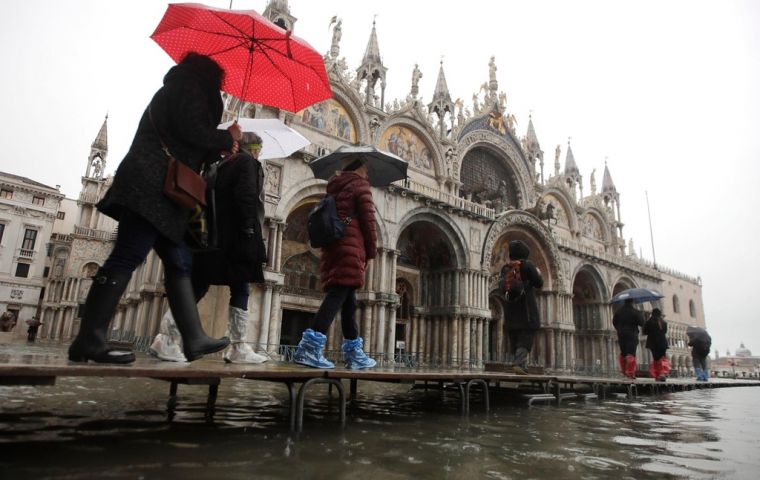MercoPress. South Atlantic News Agency
Exceptional high tide and sewage causing untold damage in Venice
 The exceptionally intense “acqua alta,” or high water, peaked at 1.87m late Tuesday, forcing stranded tourists to wade through rapidly rising waters
The exceptionally intense “acqua alta,” or high water, peaked at 1.87m late Tuesday, forcing stranded tourists to wade through rapidly rising waters  “We said last year that the Basilica had aged 20 years in a high tide. It risks having aged much more...” said Carlo Alberto Tesserin, First Procurator of the Basilica
“We said last year that the Basilica had aged 20 years in a high tide. It risks having aged much more...” said Carlo Alberto Tesserin, First Procurator of the Basilica Dirty water swirls around marble tombs inside the 12th-century crypt of St Mark's Basilica in Venice, which suffered untold damage when an unprecedented high tide swept through the city. Pumps work overtime to clear the seawater from around the altar and under the pink and white stone arches, as the historic monument's custodians look on in sadness and anger.
“We're talking about millions of euros worth of damage,” said Carlo Alberto Tesserin, First Procurator of the Basilica, who is the president of a team responsible for managing the historic site.
“We said last year that the Basilica had aged 20 years in a high tide. It risks having aged much more than that in this one,” he added.
The exceptionally intense “acqua alta,” or high water, peaked at 1.87m late Tuesday, forcing stranded tourists to wade through rapidly rising waters in the dark in search of safety as the flood alarm rang out.
Only once since records began in 1923 has the water crept even higher, reaching 1.94m in 1966.
As winds whipped the waves on the famous square, transformed into a lake, the waters surged into the Basilica with a force “never seen before, not even in the 1966 flood”, Tesserin said.
Sewage and drowned rats could be seen floating in the city's pungent alleyways.
Warnings a year ago about potential damage from increasingly high tides “went unheeded,” he said.
Thousands of tourists flock to the Italo-Byzantine monument every day, gazing up at the shimmering gold ground mosaics that decorate its majestic domes or pausing in front of the venerated tomb of St Mark.
It is particularly at risk, sitting as it does in one of the lowest parts of the city.
“The damage we see now is nothing compared to that within the walls. The salt enters the marble, the bricks, everywhere,” Tesserin said.
Italy's culture minister Dario Franceschini said the government would cough up an as-yet unspecified amount of funding to help preserve the site in the UNESCO city.
“The experts gave us ample warning. They weren't listened to,” the procurator said.
The city stands on wooden piles driven by their thousands into the mud, but rising sea levels and heavy cruise ship traffic have eaten away at the surrounding marshes and mudbanks.




Top Comments
Disclaimer & comment rulesCommenting for this story is now closed.
If you have a Facebook account, become a fan and comment on our Facebook Page!